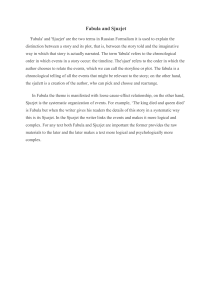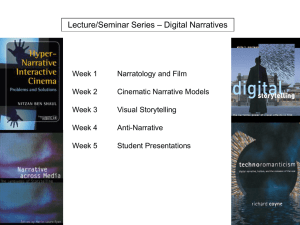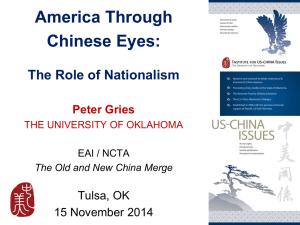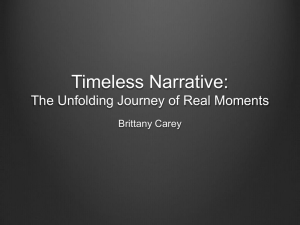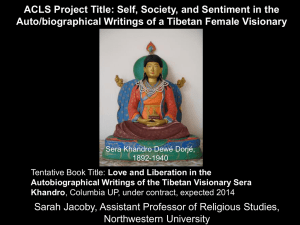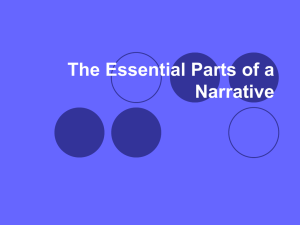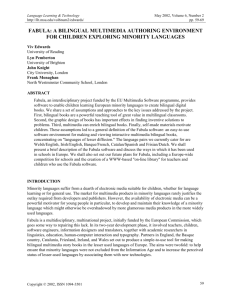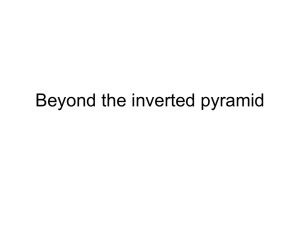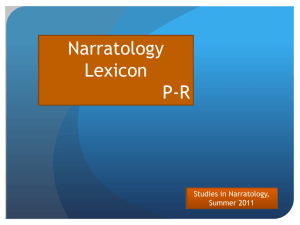mieke bal, narratology . introduction to the theory of narrative
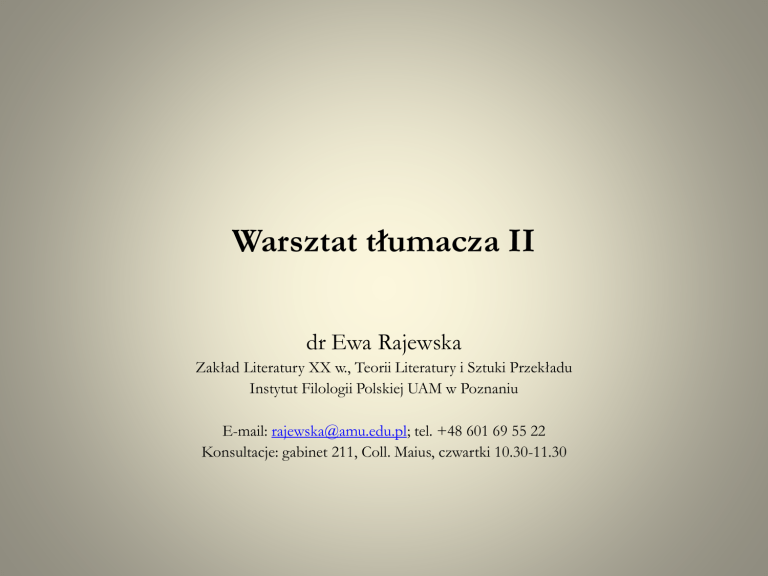
Warsztat tłumacza II
dr Ewa Rajewska
Zakład Literatury XX w., Teorii Literatury i Sztuki Przekładu
Instytut Filologii Polskiej UAM w Poznaniu
E-mail: rajewska@amu.edu.pl
; tel. +48 601 69 55 22
Konsultacje: gabinet 211, Coll. Maius, czwartki 10.30-11.30
MIEKE BAL, NARRATOLOGY. INTRODUCTION TO THE THEORY OF NARRATIVE
3 LAYERS :
TEXT
( SPEAKER )
N ARRATIVE TEXT
STORY FABULA
( CHARACTER ) ( ACTOR )
MIEKE BAL, NARRATOLOGY. INTRODUCTION TO THE THEORY OF NARRATIVE
“A narrative text is a text which an agent or subject conveys to an addressee
(‘tells’ the reader) a story in a particular medium, such as language, imagery, sound, buildings, or a combination thereof. A story is the content of that
text, and produces a particular manifestation, inflection, and ‘colouring’ of a
fabula; the fabula is a series of logically and chronologically related events that are caused or experienced by actors.” (p. 5)
MIEKE BAL, NARRATOLOGY. INTRODUCTION TO THE THEORY OF NARRATIVE
“Take the familiar story of Tom Thumb. Not everyone has read that story in the same text. There are different versions; in other words, there are different
texts in which that same story is related. There are noticeable differences among the various texts. Some texts are considered to be literary while others are not; some can be read aloud to children, others are to difficult. […]
Here, ‘text’ refers to narratives in any medium. I use this word with an emphasis on the finite nature and structuredness of narratives […]” (p. 6)
MIEKE BAL, NARRATOLOGY. INTRODUCTION TO THE THEORY OF NARRATIVE
“[T]he next distinction, that between story and fabula […] is based on the difference between the way in which the events are presented and the sequence of events as they ‘occur’ in the imaginative world of the fabula.
That difference lies not only in the language used. […T]he fabula is not exclusively language-based.” (p. 6)
MIEKE BAL, NARRATOLOGY. INTRODUCTION TO THE THEORY OF NARRATIVE
“[T]hese layers [text, story, fabula] [do not] exist independently of one another. […] The only material we have for our investigation is the text before us. [...] Only the text layer, embodied in the sign system of language, visual images, or any other, is more or less directly accessible.” (p. 7)
MIEKE BAL, NARRATOLOGY. INTRODUCTION TO THE THEORY OF NARRATIVE
“The fabula, understood as material or content that is worked into a story, has been defined as a series of events. This series is constructed according to certain rules. We call this the logic of events” (p. 7)
“Events, actors, time, and location together constitute the material of a
fabula. […] [T]hese elements are organized in a certain way into a story.
Their arrangement in relation to one another is such that they can produce the effect desired, be this convincing, moving, disgusting, or esthetic” (p. 8)
MIEKE BAL, NARRATOLOGY. INTRODUCTION TO THE THEORY OF NARRATIVE
“A fabula that has been ordered into a story is still not a text. A narrative
text is a story that is ‘told’, conveyed to recipients, and this telling requires a medium […]” (p. 9)
“The fabula is really the result of the mental activity of reading, the interpretation by the reader, an interpretation influenced both by the initial encounter with the text and by the manipulation of the story. The fabula is a memory trace that remains after the reading is completed”. (p. 10)
“A narrative text is a text in which a narrative agent tells a story” (p. 15)
MIEKE BAL, NARRATOLOGY. INTRODUCTION TO THE THEORY OF NARRATIVE
“[T]he story – the middle of the three layers I distinguish in the narrative
text – does not consist of material different from that of either the text or
the fabula, but that this material is looked at from a certain, specific angle. If one regards the text primarily as the product of the use of a medium, and
the fabula primarily as the product of imagination, the story could be regarded as the result of an ordering.” (p. 75)
MIEKE BAL, NARRATOLOGY. INTRODUCTION TO THE THEORY OF NARRATIVE
“How is it that a narrative text comes across to the reader in a certain manner? Why do we find the same fabula beautiful when presented by one writer and trite when presented by another? Why is it so difficult in a simplified edition of a classic, or of a masterpiece of world literature, to preserve the effect of the original?” (p. 75)
“Manipulation originally meant simply ‘handling’, ‘treatment’, and even though its modern sense has shifted to include more unfavourable connotations, the original meaning is still synonymous with ‘operation’.
The fabula is ‘treated’, and the reader is being manipulated by this treatment. I would like to suspend the negative connotations of manipulation, also in this second sense. It is basically at this level
[=story] that suspense and pleasure are provoked, and that ideology is inscribed.” (p. 76)
MIEKE BAL, NARRATOLOGY. INTRODUCTION TO THE THEORY OF NARRATIVE
“A fabula may be considered as a specific grouping of series of events.
The fabula as a whole constitutes a process, while every event can also be called a process or, at least, part of a process.” (p. 195-196)
“ X is a subject-actant, Y an object-actant. For instance, in a typical love
story the slots may be filled as follows: John – wants to marry – Mary.
John is subject, Mary object, and the element of intention of the fabula takes the form of ‘wanting to marry’.” (p. 203)
